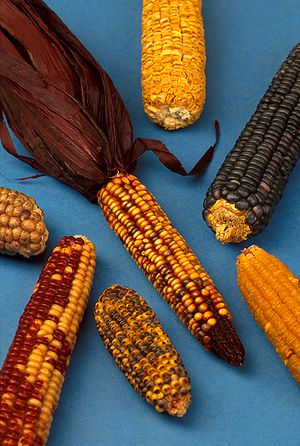Corn production in the United States
Corn production in the United States is a significant sector within the agriculture industry, contributing to a substantial portion of the global corn supply. The United States stands as one of the world's leading corn producers, with the crop playing a crucial role in both the domestic and international markets. Corn, also known as maize, is utilized in a variety of ways, including as feed for livestock, in the production of ethanol, and as a staple food product in many diets.
History[edit | edit source]
The history of corn production in the United States dates back to the indigenous peoples, who first cultivated the crop thousands of years ago. European settlers adopted corn cultivation techniques from Native Americans, and it has since become a staple in American agriculture. Over the centuries, advancements in agricultural technology and farming practices have significantly increased corn yield and efficiency of production.
Major Corn Producing States[edit | edit source]
The Corn Belt, a region in the Midwestern United States, is the heart of the country's corn production. States within the Corn Belt, including Iowa, Illinois, Nebraska, and Minnesota, are known for their fertile soil and favorable growing conditions, making them top producers of corn in the nation. These states contribute significantly to the total corn output of the United States.
Cultivation and Harvesting[edit | edit source]
Corn cultivation involves several stages, from planting to harvesting. The process begins with the selection of seed variety, taking into account factors such as climate, soil type, and resistance to pests and diseases. Modern farming techniques, including the use of genetically modified organisms (GMOs) and precision agriculture, have enhanced the efficiency and yield of corn production. Harvesting typically occurs in the fall, when the kernels have reached optimal moisture content for storage and use.
Uses of Corn[edit | edit source]
Corn is a versatile crop with a wide range of uses. The largest portion of corn produced in the United States is used for animal feed, providing a vital source of energy and nutrition for livestock. Corn is also a key ingredient in ethanol production, a renewable fuel source that has gained prominence in recent years. Additionally, corn is processed into a variety of food products for human consumption, including cornmeal, corn syrup, and sweeteners. Industrial uses of corn include the production of bioplastics, adhesives, and other bio-based products.
Economic Impact[edit | edit source]
The economic impact of corn production in the United States is substantial, influencing various sectors of the economy. The corn industry supports numerous jobs, from farming and harvesting to processing and distribution. Corn exports also play a significant role in the U.S. economy, with the United States being a major exporter of corn to countries around the world. The ethanol industry, driven by corn production, contributes to energy independence and the reduction of greenhouse gas emissions.
Challenges[edit | edit source]
Despite its importance, corn production faces several challenges, including climate change, water usage, and pest management. Climate change poses a threat to corn yields through increased temperatures, altered precipitation patterns, and more frequent extreme weather events. Water usage for corn irrigation is a concern in regions with limited water resources. Pest and disease management require ongoing research and adaptation to protect crops and maintain yields.
Future of Corn Production[edit | edit source]
The future of corn production in the United States will likely involve continued innovation and adaptation. Advances in agricultural technology, including precision farming and genetic engineering, hold promise for increasing efficiency and reducing environmental impacts. Sustainable farming practices and water conservation measures will be critical in addressing the challenges of water usage and climate change. As global demand for food and renewable energy sources grows, the role of corn production in the United States will remain vital.
Search WikiMD
Ad.Tired of being Overweight? Try W8MD's physician weight loss program.
Semaglutide (Ozempic / Wegovy and Tirzepatide (Mounjaro / Zepbound) available.
Advertise on WikiMD
|
WikiMD's Wellness Encyclopedia |
| Let Food Be Thy Medicine Medicine Thy Food - Hippocrates |
Translate this page: - East Asian
中文,
日本,
한국어,
South Asian
हिन्दी,
தமிழ்,
తెలుగు,
Urdu,
ಕನ್ನಡ,
Southeast Asian
Indonesian,
Vietnamese,
Thai,
မြန်မာဘာသာ,
বাংলা
European
español,
Deutsch,
français,
Greek,
português do Brasil,
polski,
română,
русский,
Nederlands,
norsk,
svenska,
suomi,
Italian
Middle Eastern & African
عربى,
Turkish,
Persian,
Hebrew,
Afrikaans,
isiZulu,
Kiswahili,
Other
Bulgarian,
Hungarian,
Czech,
Swedish,
മലയാളം,
मराठी,
ਪੰਜਾਬੀ,
ગુજરાતી,
Portuguese,
Ukrainian
Medical Disclaimer: WikiMD is not a substitute for professional medical advice. The information on WikiMD is provided as an information resource only, may be incorrect, outdated or misleading, and is not to be used or relied on for any diagnostic or treatment purposes. Please consult your health care provider before making any healthcare decisions or for guidance about a specific medical condition. WikiMD expressly disclaims responsibility, and shall have no liability, for any damages, loss, injury, or liability whatsoever suffered as a result of your reliance on the information contained in this site. By visiting this site you agree to the foregoing terms and conditions, which may from time to time be changed or supplemented by WikiMD. If you do not agree to the foregoing terms and conditions, you should not enter or use this site. See full disclaimer.
Credits:Most images are courtesy of Wikimedia commons, and templates Wikipedia, licensed under CC BY SA or similar.
Contributors: Prab R. Tumpati, MD






